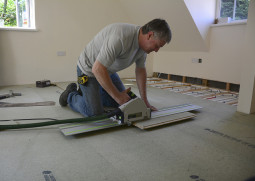 Underfloor heating is increasingly becoming a popular alternative for heating homes. Not only is it considered luxurious, comfortable and efficient, but it’s also a very affordable way of making the interior of your beautiful home warm. Whether you choose kitchen underfloor heating, bathroom underfloor heating, or conservatory underfloor heating for your home, this technique will always provide an invisible sense of warmth from the ground upwards. This system also eliminates the need for radiators, and that means you’re going to save on space within your property. Furthermore, it allows greater flexibility when designing room layouts.
Underfloor heating is increasingly becoming a popular alternative for heating homes. Not only is it considered luxurious, comfortable and efficient, but it’s also a very affordable way of making the interior of your beautiful home warm. Whether you choose kitchen underfloor heating, bathroom underfloor heating, or conservatory underfloor heating for your home, this technique will always provide an invisible sense of warmth from the ground upwards. This system also eliminates the need for radiators, and that means you’re going to save on space within your property. Furthermore, it allows greater flexibility when designing room layouts.
How exactly does underfloor heating system work?
Apparently, they work like your traditional radiators. Heat rises upwards, hit the ceiling only to travel downward again, cooling all the way down to the floor. This creates an evenly warm atmosphere with the majority of the warm air staying up in the room. This provides gentle air circulation from underneath the floor surface upwards. When this happens, you begin to feel warmth throughout the body. Furthermore, since underfloor heating covers the whole surface area of the floor, there are literally no cold spots to feel with bare foot.
Again, this alternative of heating rooms can be a good option for both new and existing buildings. It’s suitable to install in almost all floor types. They can be used on concrete floors, wooden floors, tiled floor, and carpeted floor as well. Only be sure to contact your installer and discuss the type of floor you want to work on beforehand.
Underfloor Heating Requirements
Radiant, an underfloor heating system company, provides the following as the main components used in an underfloor heating system:
1. The source of the heat must come from a boiler or a heat pump.
2 There must be a circulating pump to distribute hot water across the floor surface.
3 Flow and return manifold must be installed above the floor for easy access.
4 There must be insulation material.s
5 Underfloor heating circuit typically measures between 15mm-22mm in diameter. They also come with oxygen diffusion barrier.
6 Heat distribution to the manifold must be made of copper, steel, plastic flow and return pipework
Manifolds
Manifolds form a vital part of the underfloor heating requirements. They are used to distribute warm water right from the boiler to the rooms. They create a passage in which water can flow back and forth throughout the underfloor pipework.
A lot of manufacturers design manifolds, one above the other to ensure a more compact installation. However, a pump may be installed in the manifold package to pump water through the pipe system in the floor. Control valves are then fixed for purposes of room temperature control.
Among the underfloor heating requirements, there must be a filter, temperature gauges, automatic control valve, drain points, variable speed pumps and an automatic air vent. These components make up the manifold system.
Underfloor heating systems generate temperatures between 40-65 degrees Celsius. That means the actual temperatures of your floor will range between 23-32 degrees Celsius. This also means that underfloor heating systems heat the water to a much lower temperature than radiators do. This is very economical in the long run, and just as efficient as radiators.
Underfoor heating requirements for a traditional floor will be as follows:
Underfloor Heating Pipes, plus a 75mm screed to cover, 75mm foil back solid insulation board, visqueen damp course membrane, 100mm compacted stone to cover the solid ground, and red sand to level.
You should also note that there are various screeds available for this job, so you should consult with your installer or builder on how to prepare the sub floor.
But you can also install underfloor heating on traditional timber floors. In this case, you’ll need to lift off the floor boards, insulate the spaces between the joists, place metal spreader plates in between the joists, run the pipes in between spreader plates and then relay the floor boards. The hot pipes will heat the metal spreader plates and this will result in a warm feeling atmosphere inside the house.
If you live in a region that experiences cold climate in most parts of the year, then investing in an underfloor heating system would be ideal for you and your household. If you are not sure, you can always contact your installer for all the requirements that you may need to set up the system working in the correct order.
Featured images:
- License: Creative Commons image source
Bart Lawrence, the writer, simply loves a comfortable home. He has been promoting a lot about cost-effective and generally comfortable heating system since he lives in one of the cold places in UK
